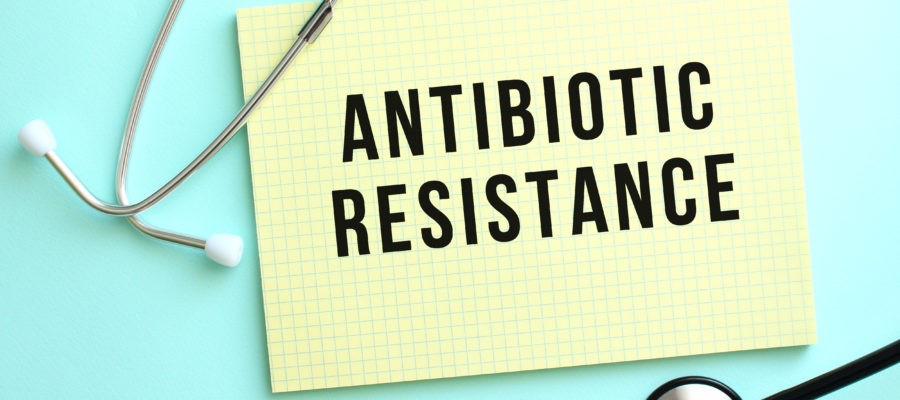Antimicrobial Resistance

By Patricia Thomblison, DVM, MS
ANTIBIOTIC RESISTANCE IN VETERINARY MEDICINE
The Centers for Disease Control and Prevention (CDC) have been in the news quite a bit since the onset of the COVID-19 pandemic, providing insight and recommendations. As the nation’s health protection agency, its mission is to protect the health of people and communities where we live, work, and play. We are currently aware of the threat COVID-19 has to our lives but it’s more than one virus we need to be concerned with. The CDC has also recognized another major threat that affects both people and their pets – antibiotic/antimicrobial resistance
ANTIMICROBIAL RESISTANCE
Antimicrobial resistance is considered one of the greatest public health challenges of our time and it impacts people and animals, including our pets. Microbes are small living organisms like bacteria and fungi. Many microbes are harmless, and some are even helpful, but some can cause infection and disease. Products used to treat these infections are called antimicrobials. The drugs typically used to treat bacterial infections are called antibiotics and those that treat fungi are antifungals. Antimicrobials are grouped in classes and the majority of the classes of antimicrobials are used in both human and veterinary medicine.
When antimicrobials don’t kill all the organisms they are targeting, resistance can occur. Germs that are left can multiply into germs that are even more resistant. Resistance can mean common infections can become harder and harder to treat. There are several different ways bacteria and fungi avoid the effects of antimicrobials. Some examples:
- Develop new cell processes to avoid using the antimicrobial target
- Use cellular pumps to get rid of the antimicrobial
- Restrict access to the antimicrobial
- Change or destroy the antimicrobial
WHO CONTRIBUTES TO ANTIMICROBIAL RESISTANCE?
Any time antimicrobials are used, such as antibiotics, they can contribute to resistance. This includes prescriptions given by physicians and veterinarians to their patients. Antimicrobials should be used judiciously and sensibly. But we should avoid using them when possible. When antimicrobials are needed, the benefits outweigh the risk of resistance developing. When an antimicrobial is prescribed for you or your pet, use the whole prescribed dose even if the symptoms or clinical signs have gone away. Never give an unused portion of your antibiotic to your other pets (or other family members).
WAYS TO REDUCE ANTIMICROBIAL USE
There are a few things we can do to support our pet’s health and do what we can to prevent infections.
- Provide good nutrition to bolster a pet’s immune system
- Reduce environmental stressors (weather extremes, crowded conditions)
- Give vaccines to protect animal health when indicated
- Provide a safe, clean, comfortable living area
- Wash hands before and after spending time with pets
- Minimize contact with allergic triggers
OTHER OPTIONS? CONSIDER ENZYME-BASED PRODUCTS
Enzymes are naturally occurring proteins that increase the rate of chemical reactions. There are lots of different types of enzymes but there are several that can provide a natural defense against harmful microbes. The patented LP3 Enzyme System in ZYMOX® is a combination of enzymes with very specific jobs which work synergistically to inhibit, split, and destroy the offending bacteria, fungi, and even some viruses making the combination antibacterial as well as antifungal. The enzymes in the ZYMOX patented formulation are lactoperoxidase, lysozyme, and lactoferrin. They work without antibiotics and only target single-cell organisms with no side effects or risk of resistance. Because they are selective, they do not harm healthy cells. As a plus, the organic matter does not need to be cleaned away because the by-product of the organic matter serves a purpose when interacting with the enzymes. Not having to clean out an infected ear of a dog or cat can make it easier to help and is also less painful for the pet.
FIRST, DO NO HARM
Antimicrobial resistance is a real public health concern we should all be aware of and do what we can to avoid. Keeping our pets healthy is the overall goal of veterinary medicine and to do so while minimizing the risk of further complications such as the development of resistant bacteria. Whenever possible, we should seek alternatives to antibiotics.
ABOUT THE AUTHOR
 Dr. Patricia Thomblison is a graduate of Oklahoma State University where she earned her Doctor of Veterinary Medicine and Master of Science. She has devoted her career to keeping pets healthy and happy. She has served many roles in this endeavor to educate veterinary professionals and pet parents on many topics of animal health. She has worn several hats in the areas of clinical pathology, nutrition, and parasitology. She is a well-respected medical editor, veterinary consultant, and lecturer. She enjoys the company of her two cats, Miles Davis and Stewart, as well as a rambunctious dog named Barnibus and her children’s dogs.
Dr. Patricia Thomblison is a graduate of Oklahoma State University where she earned her Doctor of Veterinary Medicine and Master of Science. She has devoted her career to keeping pets healthy and happy. She has served many roles in this endeavor to educate veterinary professionals and pet parents on many topics of animal health. She has worn several hats in the areas of clinical pathology, nutrition, and parasitology. She is a well-respected medical editor, veterinary consultant, and lecturer. She enjoys the company of her two cats, Miles Davis and Stewart, as well as a rambunctious dog named Barnibus and her children’s dogs.

